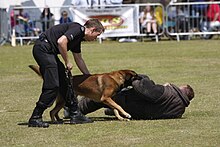
Back كلب شرطة Arabic كلب بوليسى ARZ Perru policía AST Xidməti it Azerbaijani Полицейско куче Bulgarian Policijski pas BS Gos policia Catalan سەگی پۆلیس CKB Služební pes Czech Politihund Danish



A police dog, also known as a K-9 (portmanteau of canine),[1]is a dog that is trained to assist police and other law enforcement officers. Their duties may include searching for drugs and explosives, locating missing people, finding crime scene evidence, protecting officers and other people, and attacking suspects who flee from officers. The breeds most commonly used by law enforcement are the German Shepherd, Belgian Malinois, Bloodhound, Dutch Shepherd, and Labrador Retriever.[2] In recent years, the Belgian Malinois has become the leading choice for police and military work due to their intense drive, focus, agility, and smaller size, though German Shepherds remain the breed most associated with law enforcement.[3]
Police dogs are used on a federal and local level for law enforcement purposes in many parts of the world. They are often assigned to what in some nations is referred to as a K-9 Unit, with a specific handler, and must remember several verbal cues and hand gestures.[4] Initial training for a police dog typically takes between eight months and a year, depending on where and how they are trained, and for what purpose. Police dogs often regularly take training programs with their assigned handler to reinforce their training.[5] In many countries, intentionally injuring or killing a police dog is a criminal offense.[6][7]
- ^ "About K-9s". National Police Dog Foundation. Retrieved 22 May 2022.
K-9 or K9 (a homophone of canine)
- ^ "What Do K-9 Police Dogs Do?". American Kennel Club. 3 September 2021. Retrieved 22 May 2022.
- ^ "What Breeds Make the Best drugs Dogs". 3DK9 Detection Services. 28 October 2020. Retrieved 3 June 2022.
German Shepherd Dog. The typical breed associated with law enforcement work.
- ^ "K9 Unit: Duties and Responsibilities". New York State Department of Environmental Conservation. Archived from the original on 3 August 2017. Retrieved 22 May 2022.
They are expected to follow both verbal and hand commands of their handler.
- ^ "FAQs". AMSOIL Northland Law Enforcement K-9 Foundation. 2021. Retrieved 22 May 2022.
- ^ "18 USC 1368 – Harming Animals Used in Law Enforcement". United States Code. 26 October 2015. Retrieved 26 May 2022 – via OneCLE.
- ^ "Police dogs and horses to receive special protections in South Australia". ABC News. Australian Broadcasting Corporation. 26 August 2013. Retrieved 25 February 2018.